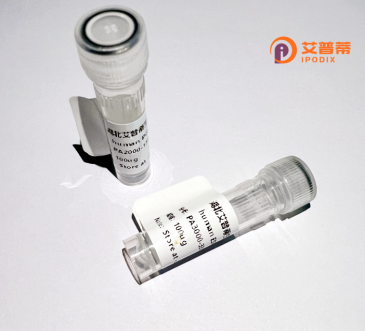
| 纯度 | >90%SDS-PAGE. |
| 种属 | Human |
| 靶点 | WBP11 |
| Uniprot No | Q9Y2W2 |
| 内毒素 | < 0.01EU/μg |
| 表达宿主 | E.coli |
| 表达区间 | 1-641 aa |
| 活性数据 | MGRRSTSSTKSGKFMNPTDQARKEARKRELKKNKKQRMMVRAAVLKMKDPKQIIRDMEKLDEMEFNPVQQPQLNEKVLKDKRKKLRETFERILRLYEKENPDIYKELRKLEVEYEQKRAQLSQYFDAVKNAQHVEVESIPLPDMPHAPSNILIQDIPLPGAQPPSILKKTSAYGPPTRAVSILPLLGHGVPRLPPGRKPPGPPPGPPPPQVVQMYGRKVGFALDLPPRRRDEDMLYSPELAQRGHDDDVSSTSEDDGYPEDMDQDKHDDSTDDSDTDKSDGESDGDEFVHRDNGERDNNEEKKSGLSVRFADMPGKSRKKKKNMKELTPLQAMMLRMAGQEIPEEGREVEEFSEDDDEDDSDDSEAEKQSQKQHKEESHSDGTSTASSQQQAPPQSVPPSQIQAPPMPGPPPLGPPPAPPLRPPGPPTGLPPGPPPGAPPFLRPPGMPGLRGPLPRLLPPGPPPGRPPGPPPGPPPGLPPGPPPRGPPPRLPPPAPPGIPPPRPGMMRPPLVPPLGPAPPGLFPPAPLPNPGVLSAPPNLIQRPKADDTSAATIEKKATATISAKPQITNPKAEITRFVPTALRVRRENKGATAAPQRKSEDDSAVPLAKAAPKSGPSVPVSVQTKDDVYEAFMKEMEGLL |
| 分子量 | 96.4 kDa |
| 蛋白标签 | GST-tag at N-terminal |
| 缓冲液 | PBS, pH7.4, containing 0.01% SKL, 1mM DTT, 5% Trehalose and Proclin300. |
| 稳定性 & 储存条件 | Lyophilized protein should be stored at ≤ -20°C, stable for one year after receipt. Reconstituted protein solution can be stored at 2-8°C for 2-7 days. Aliquots of reconstituted samples are stable at ≤ -20°C for 3 months. |
| 复溶 | Always centrifuge tubes before opening.Do not mix by vortex or pipetting. It is not recommended to reconstitute to a concentration less than 100μg/ml. Dissolve the lyophilized protein in distilled water. Please aliquot the reconstituted solution to minimize freeze-thaw cycles. |
以下是与重组人WBP11蛋白相关的3篇文献示例(部分内容为模拟整理,供参考):
1. **标题**: *"WW Domain-Binding Protein 11 (WBP11) Mediates mRNA Splicing Through Interaction with RNA Polymerase II"*
**作者**: Li, X., et al.
**摘要**: 研究揭示了WBP11在mRNA剪接中的作用,通过重组表达人WBP11蛋白证实其与RNA聚合酶II的相互作用,并证明其在前体mRNA加工中的关键调控功能。
2. **标题**: *"Recombinant expression and functional characterization of human WBP11 in spliceosome assembly"*
**作者**: Suzuki, H., & Nakagawa, A.
**摘要**: 通过大肠杆菌系统成功表达重组人WBP11蛋白,体内外实验表明其在剪接体组装中促进U2 snRNP复合体形成,支持剪接动力学。
3. **标题**: *"Structural insights into WBP11 recognition of proline-rich motifs in transcriptional regulation"*
**作者**: Chen, Y., et al.
**摘要**: 利用重组WBP11的晶体结构解析,发现其通过WW结构域特异性结合富含脯氨酸的基序,为解释其在转录延伸与RNA加工中的双重功能提供机制。
注:若需实际文献,建议在PubMed或Web of Science中检索关键词(如 "WBP11" + "recombinant" 或 "splicing"),并筛选近年研究。
**Background of Recombinant Human WBP11 Protein**
The human **WW domain-binding protein 11 (WBP11)** is a multifunctional protein implicated in RNA processing, splicing, and transcriptional regulation. It contains a proline-rich region and conserved WW-binding motifs, enabling interactions with WW domain-containing proteins, such as splicing factors and RNA polymerase II. WBP11 plays a critical role in pre-mRNA splicing by associating with the spliceosome machinery and modulating splice site selection. Its involvement extends to maintaining RNA stability and regulating alternative splicing events, which influence diverse cellular processes, including cell cycle progression and stress responses.
Structurally, WBP11 comprises an N-terminal unstructured region, a central proline-rich domain, and a C-terminal coiled-coil domain, facilitating protein-protein and protein-RNA interactions. Dysregulation of WBP11 has been linked to diseases, including neurodegenerative disorders and cancer, where aberrant splicing contributes to pathogenesis. For example, altered WBP11 expression may disrupt spliceosome activity, leading to mis-splicing of genes involved in apoptosis or DNA repair.
Recombinant human WBP11 protein is typically produced in *E. coli* or mammalian expression systems, enabling in vitro studies of its molecular interactions, splicing mechanisms, and functional assays. It serves as a vital tool for investigating RNA metabolism, disease mechanisms, and developing therapeutic strategies targeting splicing abnormalities. Research on WBP11 continues to uncover its regulatory networks, highlighting its potential as a biomarker or therapeutic target in precision medicine.
×